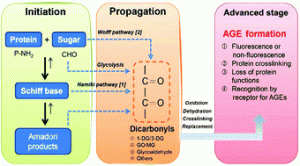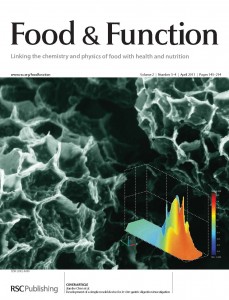This month sees the following articles in Food & Function that are in the top ten most accessed:-
Anti-inflammatory activity of natural dietary flavonoids
Min-Hsiung Pan, Ching-Shu Lai and Chi-Tang Ho
Food Funct., 2010, 1, 15-31 DOI: 10.1039/C0FO00103A, Review
Development of a simple model device for in vitro gastric digestion investigation
Jianshe Chen, Vishwajeet Gaikwad, Melvin Holmes, Brent Murray, Malcolm Povey, Ye Wang and Ying Zhang
Food Funct., 2011, 2, 174-182 DOI: 10.1039/C0FO00159G, Paper
Expression of carotenoid biosynthetic pathway genes and changes in carotenoids during ripening in tomato (Lycopersicon esculentum)
Kanakapura Krishnamurthy Namitha, Surya Narayana Archana and Pradeep Singh Negi
Food Funct., 2011, 2, 168-173 DOI: 10.1039/C0FO00169D, Paper
Bioactive peptides derived from milk proteins and their health beneficial potentials: an update
Ravinder Nagpal, Pradip Behare, Rajiv Rana, Ashwani Kumar, Manoj Kumar, Sanu Arora, Fransesco Morotta, Shalini Jain and Hariom Yadav
Food Funct., 2011, 2, 18-27 DOI: 10.1039/C0FO00016G, Review
Review of in vitro digestion models for rapid screening of emulsion-based systems
David Julian McClements and Yan Li
Food Funct., 2010, 1, 32-59 DOI: 10.1039/C0FO00111B, Review
Antiproliferative mechanisms of quercetin in rat activated hepatic stellate cells
Li-chen Wu, In-wei Lu, Chi-Fu Chung, Hsing-Yu Wu and Yi-Ting Liu
Food Funct., 2011, 2, 204-212 DOI: 10.1039/C0FO00158A, Paper
Antioxidant and antihepatotoxic effect of Spirulina laxissima against carbon tetrachloride induced hepatotoxicity in rats
Gini C. Kuriakose and Muraleedhara G. Kurup
Food Funct., 2011, 2, 190-196 DOI: 10.1039/C0FO00163E, Paper
(-)-Epigallocatechin-3-gallate increases the expression of genes related to fat oxidation in the skeletal muscle of high fat-fed mice
Sudathip Sae-tan, Kimberly A. Grove, Mary J. Kennett and Joshua D. Lambert
Food Funct., 2011, 2, 111-116 DOI: 10.1039/C0FO00155D, Paper
Comparison of the polyphenolic composition and antioxidant activity of European commercial fruit juices
Gina Borges, William Mullen and Alan Crozier
Food Funct., 2010, 1, 73-83 DOI: 10.1039/C0FO00008F, Paper
Normalization genes for quantitative RT-PCR in differentiated Caco-2 cells used for food exposure studies
Robert A. M. Vreeburg, Shanna Bastiaan-Net and Jurriaan J. Mes
Food Funct., 2011, 2, 124-129 DOI: 10.1039/C0FO00068J, Paper
Why not take a look at the articles today and blog your thoughts and comments below.
Fancy submitting an article to Food & Function? Then why not submit to us today or alternatively email us your suggestions.















